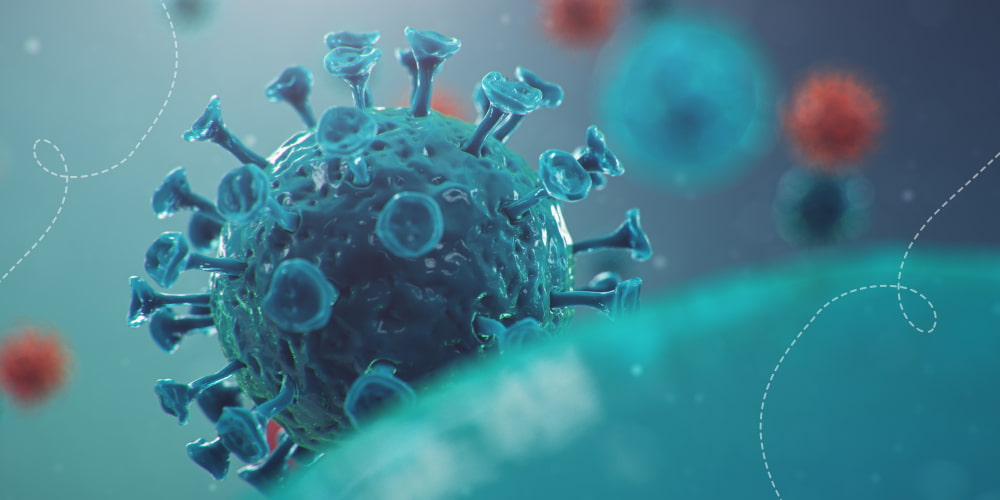As of the end of May 2021, a respiratory illness referred to as coronavirus has swept the world, and the United States has now known about more than 34 million cases. Due to the rate and extent of the infection, it is already known today that this is an extremely unusual disease. In particular, due to the fact that it affects a number of body systems, including the heart and brain. Also, often appears a statement that people who have contracted coronavirus have begun to lose their sense of smell – which again indicates involvement in the integrity of the human nervous system.
With the subsequent waves of this disease, society began to complain of new neurological complications and became known cases of strokes, the main cause of which was COVID-19. At the end of 2020, it was found that SARS-CoV-2 enters the brain through the blood-brain barrier with the help of the forming of the spike protein. Thus, in the tissues of the brain, it leads to an inflammatory disease that causes neurological complications that persist even after recovery. In this article, we will take a closer look at why and how coronavirus relates to a neurological topic and the reasons why it is worth undergoing medical examinations.
Features of coronavirus infection
COVID-19 most often affects the lungs, so the most common symptoms of the disease are coughing and shortness of breath. In the most severe cases, patients require mechanical ventilation. However, infection also often leads to neurological symptoms, ranging from headaches to seizures and these complications can persist for a very long time.
The hypothesized reason for this is the entry of the virus into the brain. But the specific mechanisms of how this happens were not fully understood until researchers began to infect mice with it through the respiratory tract and intravenously. Also, German scientists helped to compile a complete picture. It turned out that:
- SARS-CoV-2 is able to enter the brain via the olfactory nerve. It stretches from the nasal mucosa into the cranial cavity, where it passes into the olfactory bulb, and it – into the olfactory tract, and further to the olfactory analyzer in the cerebral cortex. Thus, having penetrated into the cells of the nerve, the virus can rise to the brain and enter its different parts.
- Then the S1 protein allows SARS-CoV-2 to cross the blood-brain barrier – a “filter” between the circulatory system and the central nervous system. It protects the nervous tissue from microorganisms circulating in the blood, toxins, cellular and humoral factors of the immune system, which perceives the brain tissue as foreign.
This is not a unique phenomenon – a number of other viruses also have this property. Most of all, the behavior in the second step of SARS-CoV-2 infection in this regard reminded scientists of HIV. According to the author of the work, William Banks, the S1 protein in SARS-CoV2 and the gp 120 protein in the HIV-1 virus function in a similar way. Both have proteins-glycoproteins on the surface, which work like the “hands” of the virus, “grabbing” the receptors and penetrate the cells. Both viruses cross the blood-brain barrier, and S1, like gp120, is considered toxic to brain tissue.
It turned out that with COVID-19, breathing problems arise, not only because the infection enters the lungs but because the coronavirus enters the respiratory centers of the brain and disrupts their work. Minor inflammation can occur in response to any viral infection. In some people, especially the elderly or those with chronic illnesses, the immune system overreacts to an infection and gets out of control, leading to a cytokine storm – uncontrolled inflammation that damages the body’s own tissues. Cytokine storm is one of the most common causes of death in COVID-19. Researchers believe that a similar response in the brain causes long-term neurological complications after the illness.
What neurological complications can the coronavirus cause?
Although studies do not fully confirm the veracity of their theories, researchers still link many of the identified complications to the autopsies of infected patients. To date, more studies are known to support the prevalence of neurological abnormalities in patients with coronavirus, including mild symptoms and severe consequences such as:
- headaches
- loss of smell (anosmia)
- tingling sensations (arcoparesthesia)
- aphasia (inability to speak)
- strokes and seizures
- local hypoxic damage caused by a lack of oxygen and concomitant heart attacks (or ischemic strokes)
- bleeding in the brain
- acute disseminated encephalomyelitis.
The virus, previously considered a common respiratory illness, can also wreak havoc on the kidneys, liver, heart, and virtually all body systems. Not to mention the study, which revealed such consequences of the coronavirus as confusion, inattention, disorientation, or poorly organized movements in response to commands. Unfortunately, the global nature of the problem was not previously known since not every symptom identified was associated with this disease. In other words, doctors could not recognize neurological abnormalities.
But today, the prevalence of the problem is attracting an ever-larger audience. Doctors work tirelessly to understand all the neurological complications that coronavirus causes. Today it is believed that several different disease processes are at work:
- Complications from intensive care. This includes long-term cognitive problems and an increased risk of anxiety and depression.
- Inflammatory or immune response. It provokes problems throughout the body, in particular, encephalitis and acute disseminated encephalomyelitis. Patients with encephalitis may experience mild flu symptoms such as headaches, fever, and fatigue, or may experience more serious symptoms including confusion, seizures, paralysis, speech or hearing problems, and more.
- Stroke. It became known that the coronavirus causes the formation of blood clots, large and small, which can enter the brain and cause a stroke. It can be identified as the first neurological complication, when common symptoms such as cough may be at an early stage of exacerbation.
- Viral infection of the brain. There are cases when the virus was in the cerebrospinal fluid, which means an increased chance of infection of brain cells.
We hope that our article was useful to you. Remember, some of the brain damage from coronavirus can be irreversible. Therefore, it is worth taking tests for the disease and pass neurological examinations in the presence of even mild symptoms of coronavirus.












Please, leave your review
Write a comment: